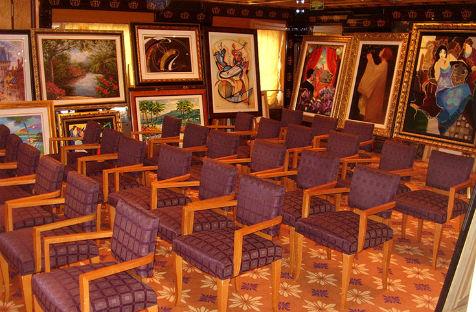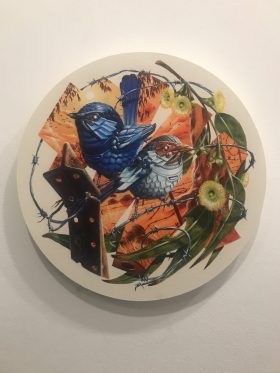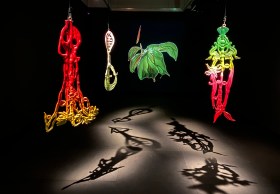Retail auction houses and online sales are the way of the future.
To the casual observer, the art market can be a perplexing business. It’s a mystifying combination of commerce and aesthetics, which can be difficult to interpret and even more difficult to explain.
While the highs and lows are widely reported, less dramatic news is reserved for publications read mainly by the trade. In 2012, Munch’s The Scream created a press sensation when it achieved a global high of almost USD $120 million, but the majority of transactions which make up the €20.9 billion global fine and decorative art auction market involve far less robust sums.
Australia’s contribution to the global art auction economy is modest, with total auction sales here for 2012 achieving AUD $95.08 million, which is less than one Munch. Although in breakdowns of global art market share, Australia is relegated to the section entitled ‘the rest’, auction houses and galleries form an important part of Australia’s cultural and financial economy. They also help artists establish and perpetuate their reputations and provide a means for collectors to grow and refine their collections.
However, the way in which auctioneers and galleries are doing this is rapidly changing. Economics is definitely a factor, with many art-related businesses struggling in the post GFC world. While Australia’s 2012 art auction turnover is 4.8% down on the previous year, it represents a massive 46% decrease from the total achieved in 2007.
Additionally, changes in retail, advertising and print media, brought about by the growth of new technologies and changed consumer habits, have also made their mark. In response to these challenges, gallery owners and auction houses are pursuing new markets and opportunities, which are increasingly blurring the lines between them.
Here are three things we can expect to see more of in 2013.
Auction Houses Becoming Increasingly Retail
Traditionally, a typical auction house sales calendar features three art auctions per year between March and November, with each auction consisting of a three-day viewing period, followed by the auction itself. Successful bidders are expected to bid, pay and collect within a few days, leaving little time for deliberation on the part of the buyer.
Although auction houses commonly sell individual art works to select clients by private treaty between auctions, they are increasingly turning to gallery-style exhibitions, in order to maximise use of their rooms and bring new clients through the door.
A selling exhibition, which can extend to some weeks, has a considerably longer life span than the average auction viewing, giving the buyer far more time in which to make a considered purchase. Whereas selling exhibitions provide the certainty of set prices, auction catalogues typically state an estimate range (for example $40,000-50,000). There is no guarantee that the work will sell within the estimate range, with hotly contested examples often exceeding their estimates. Additionally, the hammer price attracts a buyer’s premium which is upwards of 20% and this can result in anxious moments and frantic mental calculations, which may not appeal to more cautious buyers.
Galleries Scaling Back Retail Operations
While auction houses are becoming increasingly retail, many gallery owners are in the process of rationalising their gallery spaces. In a move which surprised many, art market veteran, Rex Irwin, left his gallery in Queen Street, Woollahra, earlier this year and pooled his resources with Tim Olsen. Both are now operating from Olsen’s Jersey Road gallery, albeit with a reduced stable of artists. It is hoped that the combination of Irwin’s strong track record in selling high-end art and Olsen’s commercial success, coupled with a mutual reduction in overheads, will be of commercial advantage, while providing flexibility for them to attend art fairs, which are becoming increasingly important to gallery sales.
Other galleries are reducing the number of premises they operate from, or the number of exhibitions they hold each year, and some are even abandoning their physical gallery spaces altogether. In 2012, Sydney gallery owners, Barry Keldoulis and Iain Dawson, did just that, favouring an online presence, pop-up exhibitions and a presence at art fairs, both here and overseas. Interestingly, Barry Keldoulis has just been appointed Chief Executive of ‘Sydney Contemporary’, Sydney’s first high-end art fair, which is to be staged in September.
Whether galleries can survive without a permanent physical presence is open to debate and some argue that gallery closures are motivated more by financial necessity, than the desire to pursue opportunities elsewhere. However, for many operators, it is not an either/or situation. They need to maintain a physical presence (albeit with reduced overheads) and have the flexibility to do other things. Many gallery owners are consolidating in order to do just that.
Online sales
A walk down Sydney’s Oxford Street leaves you in no doubt about the impact that the internet has had on retail sales. While this has had an obvious effect on commercial galleries, auction houses have not remained unscathed. Traditionally, auction houses have relied on networks of dealers, both large and small, who act as intermediaries between them and private clients. With auctions and selling prices now being widely reported on the web, it is becoming increasingly difficult for dealers to make a profit and much easier for people to source art works at auction themselves, instead of paying a middleman to do it for them.
Most Australian auction houses have adopted online bidding, which not only gives them an increased global reach, but also encourages the participation of time poor locals and people who prefer the anonymity of a virtual auction experience. While many Australian auction houses and their clients are not yet ready to conduct the entire process online (particularly for higher level works) a strong online presence is a must.
Internationally, Christie’s New York recently conducted a hugely successful online-only sale of works by Andy Warhol. Bidders from 36 countries vied for the 120 plus works on offer, with 99% of works finding new homes and the sale raising twice as much as expected. Christie’s plans a total of 40 online auctions this year, compared with the seven they held in 2012.
Typically, auction houses don’t arrange shipping, but with clients becoming used to services, such as eBay and Amazon.com, this may soon change. In the UK, the sale-room.com, Europe’s pre-eminent online bidding platform for fine art and antiques, is pilot testing a model which provides an end-to-end experience for auction buyers. The new division is headed by Australian expatriate, Marika Clemow, who says that the service, which should be operational later in the year, ’will take auctions to the next level.’ Ms Clemow adds that that the initiative is designed to ‘invite retail customers to participate at auctions, not just dealers or people who are already familiar with the auction market.’
The advent of internet bidding has made it easier than ever before to experience the auction world. Curious onlookers and prospective clients are able to watch sales live from their living rooms without feeling the compulsion to buy. While it has always been possible to attend auctions as a spectator, many feel uncomfortable about entering a world which they aren’t familiar with.
Although it’s frequently lamented that much of what happens in the art market occurs behind closed doors, fixed price selling exhibitions, online galleries, art fairs and internet bidding are gradually opening it up to the outside world. These days, exploring the art market can be as simple as switching on your computer.





